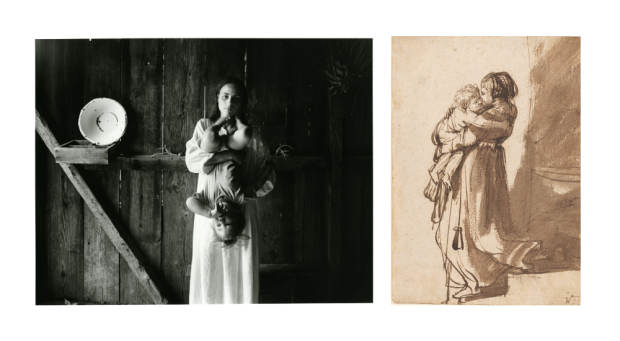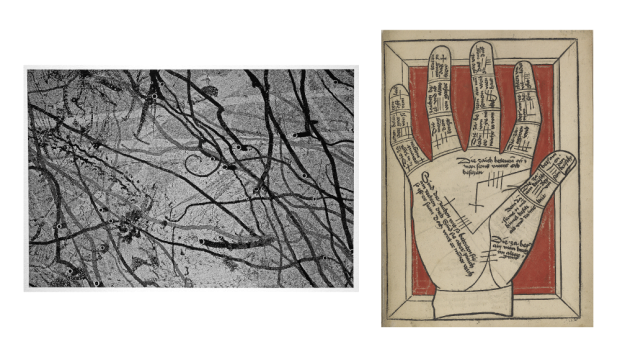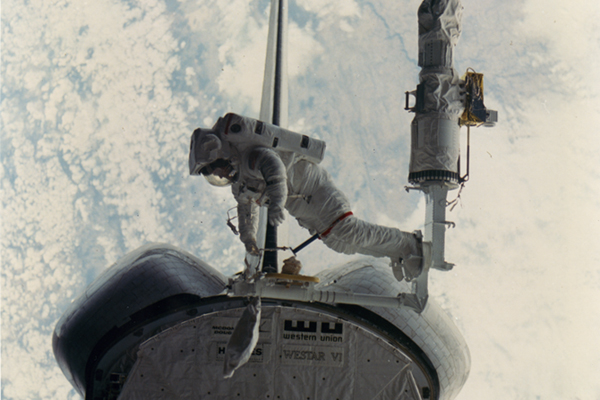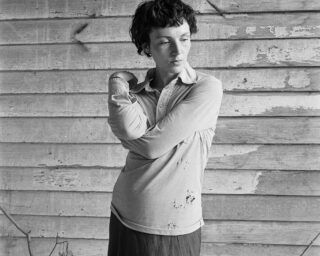Behind the Scenes of Emmet Gowin at the Morgan Library and Museum
Behind the Scenes of Emmet Gowin at the Morgan Library and Museum
Joel Smith as told to Alexandra Pechman

Emmet Gowin, Edith, 2004 (Rain Droplets in a Web). Gold- toned salt print on gelatin coated paper. Collection of Emmet and Edith Gowin. © Emmet and Edith Gowin, courtesy Pace/MacGill Gallery.
Throughout his prolific career as a photographer, Emmet Gowin has threaded together seemingly disparate subjects: his wife, Edith, and their extended family; American and European landscapes; and aerial views of environmental devastation. In 2013, Aperture copublished a long-awaited survey publication, Emmet Gowin, in conjunction with a related exhibition organized by Fundación Mapfre, Madrid. On May 22, the Morgan Library and Museum opened Hidden Likeness, a show of Gowin’s photographs from throughout his career paired with selections he made from the museum’s vast holdings of ancient Near Eastern seals, medieval books, music manuscripts, and prints and drawings, as well as photographs. Online editor Alexandra Pechman spoke with Joel Smith, Richard L. Menschel Curator and Department Head, Photography, during a tour of the exhibition during its installation in early May. In June, Aperture Foundation Members at the Patron level will have a private tour of the exhibition led by Smith. What follows are a few selections from Smith’s commentary on how the Gowin show came together. This article also appears in Issue 8 of the Aperture Photography App, a new biweekly publication from Aperture: click here to download the free app.
On the Exhibition’s Beginnings
If you look at an artist’s work and say, “What other work would help to explain their work or bring out themes?” in Emmet Gowin’s case, it would need to be a very rich, long list of things precisely because of the range of things that he does and the depth of each. I’ve known about his great love of William Blake as well as Dürer and Old Masters, so that knowledge infected my eye in looking at his work. What I really wanted to do was to leave those relationships to speak for themselves—not to come up with thematic categories that he had to fit into, but to really have a free-flowing visual relationship between his body of work and the kinds of things that the Morgan has. . . . Emmet started coming in last spring for a day at time, and I made appointments with the curators [in other departments]. Based on their conversations, we could pull things to show. So we wound up with a group of a couple hundred objects and cut down from there to about fifty as we talked about which pieces of his own he wanted to include. In terms of his work, we were trying to choose a large number of [photographs] that had maybe been shown only once, as well as a few that are the anchors that people know.

(Left) Emmet Gowin, Edith and Elijah, Danville, Virginia, 1968. Gelatin silver print. Collection of Emmet and Edith Gowin. © Emmet and Edith Gowin, courtesy Pace/MacGill Gallery. (Right) Rembrandt Harmensz. van Rijn (1606–1669), Woman with a Child Descending a Staircase, ca. 1636. Pen and brown ink, brown wash. Purchased by Pierpont Morgan, 1909, The Morgan Library & Museum.
Edith
She is a common thread that runs throughout his career, so she appears a number of times in the show. Those portraits you see in combination with, for example, Frank Albert Rinehart’s portrait from an 1898 Indian conference in Omaha, Nebraska [Eneas Michel, Flatheads, 1898], a photograph that I acquired just a couple of years ago. Emmet loved the way the man maintains his dignity even in this totally imposed, unnatural context that’s determined by the photographer…he saw [this] as a common element with Edith. There are portraits of Edith from 1967 all the way up to 2009, paired with Gauguin, Rembrandt, Degas. Happily there is this picture [top] of Edith that is a “hidden likeness”: it’s actually a photograph of a photograph. Emmet made pictures of Edith that he took traveling with him, as a way of bringing Edith along. There had been a rain shower outside on his porch in Pennsylvania, and when he looked out he saw a spider web that had droplets of rain in it and a leaf. He went back in the house and got his camera as well as one of those portraits, and he just slipped it behind the spider web. The web disappeared, and there’s nothing but the water which becomes this veil over her face. So the photograph of her is from maybe ten or twelve years earlier, though this photograph is recent.

(Left) Emmet Gowin, French Guiana, Insect Movement, 2010. Archival digital inkjet print. Collection of Emmet and Edith Gowin. © Emmet and Edith Gowin, courtesy Pace/MacGill Gallery. (Right) Johann Hartlieb (active 1450), Die Kunst Chiromantia (The Art of Chiromancy). Augsburg: Georg Schapf, ca. 1475. Ink and wash on paper. Purchased with the Bennett Collection, 1902, The Morgan Library & Museum.
Relationships between objects
There are artistic relationships and surprises in the show: there’s a very early Lyonel Feininger academic study that has nothing to do with what he did later as an artist but is formally so beautiful. . . . These fit with the image of the paths of moths and droplets of water on a tent surface in the jungle, from when Emmet was photographing moths in the rainforest [above]. He made a few of these and, in the booklet, we paired this with a palm from a very early printed book. Some of these [moth path] images have never been shown: the cloth of the tent gets wet at night in the rainforest, soaked, and then you can see the moths land on it, droplets of water run down it, you can see the feet of the moth—I love where this one walked in a circle.

(Left) Emmet Gowin, Copper Ore Tailing, Globe, Arizona, 1988. Toned gelatin silver print. Collection of Emmet and Edith Gowin. © Emmet and Edith Gowin, courtesy Pace/MacGill Gallery. (Right) William Blake (1757–1827), Behemoth and Leviathan (illustration for the Book of Job), ca. 1805–10. Pen and black and gray ink, gray wash, and watercolor, over faint indications in graphite. Purchased by Pierpont Morgan, 1909, The Morgan Library & Museum.
Terrible Beauty
William Blake is a favorite of Emmet’s, and I wanted to get [Emmet’s] aerial photographs in from the beginning. These two images [above] are paired at the beginning of the show and both have this demonic beauty to them. . . . We will have an event later in the run of the show on September 10 called “Terrible Beauty,” where Emmet will speak on the subject of beauty in catastrophe. The beginning of [the idea of terrible beauty] can be seen in his views of Matera, Italy, made in 1980, a couple years after an earthquake that made parts of the city uninhabitable. Around the same time he was photographing Mount St. Helens, where he was beginning to have that almost aerial perspective. It was in the course of doing the aerial work that he flew over Hanford [Nuclear Reservation near Richland, Washington] and realized there’s this whole nuclear story in the U.S. to be told through photographs.
The title (Hidden Likeness)
[At the] Morgan, we have not only works of art but all of these other things like books, musical manuscripts, and objects such as Coptic bindings, that are really not there for their visual characteristics at all, but for their historical significance. Those are things I just knew Emmet was going to respond to, and I wanted to do something that would bring out the richness of what the Morgan has; he was an ideal instrument to get at that depth. This title, Hidden Likeness, came about because I asked Emmet if I could look through his old notebooks where he had written quotations down and so on. It was actually the transcript of a talk in which he said, “Jacob Bronowski [biologist, mathematician, and author of The Ascent of Man] would have called this a hidden likeness,” and I didn’t even know what it referred to, but I liked the phrase. It wound up explaining very nicely what I saw here: in the range of what the Morgan has and in the range of what Emmet does, there’s a likeness that nobody meant to produce but was there waiting to be found.
Size and intimacy
Another element of likeness is simply one of scale. The largest thing Emmet has ever created as a photographer is about [handheld] size, and that’s the kind of range in which the Morgan’s collection exists—we don’t have a painting collection, we don’t have sculptures in any great number. There was something about that human scale that felt like an affinity as well. Photography is all sorts of different things now, and for some photographers it’s something electronic and for some it’s something monumental, but Emmet really does work in a tradition that speaks historically to the kind of tradition that the Morgan is about. He works toward a piece of paper, or the size of something you might hold in your hand. That kind of intimate feature of the objects is something I hope that people will experience by seeing the show.


























